
Most people would agree, take lots of water, utilize shade and pace yourself.
There are a number of considerations when hiking in the Southwest. Here's some that are often overlooked.
FIRST AND FOREMOST - TAKE WATER. Please read my post, SUMMER DESERT HIKING TUTORIAL below. The Sonoran Desert is an unforgiving extreme environment that is underestimated everyday by visitors AND locals alike. Take more water than you think you will need and take an extra bottle for somebody you come across in trouble.
TELL SOMEBODY YOUR PLANS - Tell a friend where you are going and when you plan to be back. It doesn't hurt to give them the number of the closest ranger station or other emergency services nearby. Make sure they know when you'll check in and what to do if you don't.
This website has some excellent info on this; http://www.desertusa.com/desert-activity/desert-survival-tips.html#

NAVIGATION - Distances in the desert can be difficult to judge at times. Sometimes what looks a long way off is not and sometimes it's the other way around. The desert plays tricks on you. Dust, shadow, mirage and a lack of size reference landmarks can cause serious misjudgment of distance. A map and compass are always handy. On the other hand, the wide open ranges allow for incredible fields of view and if you know landmarks, a map is often not needed at all. Confusing, huh?
In some areas, like the Superstition Mountains or in the canyons, it is easy to get turned around, become disoriented and get lost. Canyons wind around towering rock formations. The clarity makes long distances seem short. And to make things worse there is very, VERY little water. Many have paid the price for underestimating the desert.
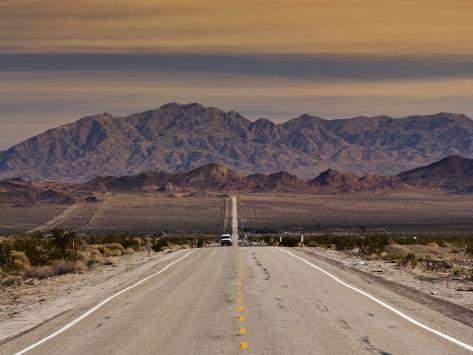 |
| In this pic, the distant mountains are about 2 miles away. |
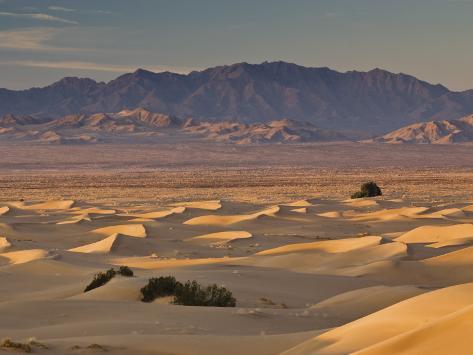 |
| Here the distant mountains are almost 8 miles away. |
Do not rely exclusively on cell phone for navigation. Signals are spotty at best in many areas and dirt roads change. A wash (dry creek bed) may cut a deep impassable channel thru what was once a road.
Barrel Cactus lean to the south (to reduce their exposure to the sun).
Saguaro cactus will congragate on the south side of hills. This helps them prevent freezing during the winter months.
Cottonwood trees and other large-leaf trees will often grow near a water source.
Many of our streams run underground. You may need to dig in order to discover flow direction. Sometimes only a foot or 2 down.
GATES - We have a lot of cattle. In some areas ranches and wilderness boundaries are often confusing. Fences often keep cattle out of wilderness areas. Some trails will have gates in fences you will need to go through.
WHAT TO DO - Always Close Gates Behind You. Be aware of private property.
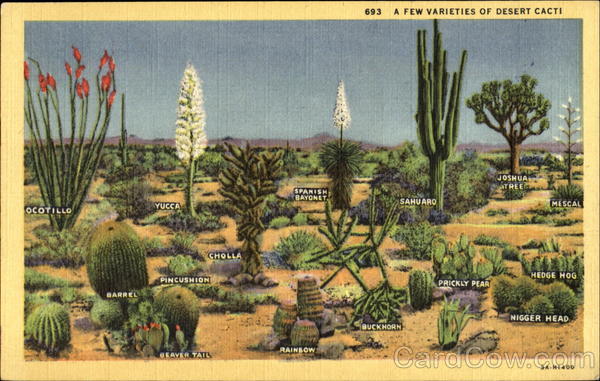
CACTUS - Prickly plants are everywhere in the desert. Some of them, like the Cholla, are particularly nasty when encountered up close and personal. It is often called "jumping cholla" because the pods can fall off if brushed against or shaken and then bounce off each other making it seem to jump at ya. Some cactus look soft, fuzzy and cuddly, don't be fooled. The hair-like thorns will embed themselves into skin and hurt and fester and... just don't touch um.
| This will give ya a size reference for the Saguaro Cactus. |
Walk animal trails as they are often easier going through thick areas.
Pull big spines out with tweezers or needle nose pliers.
For small hair-like thorns lay duct tape over them running along the out direction, press then pull off fast. Repeat.
For cholla pods, use a comb or 2 sturdy sticks slid between the pod and skin , then yank aggressively.
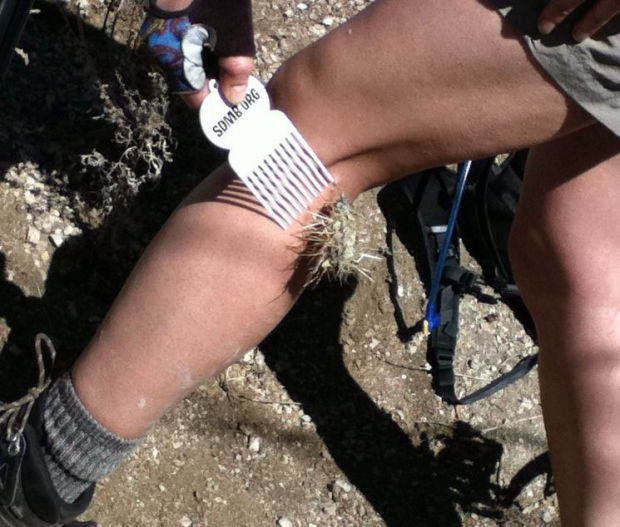
MIRAGE - With such high temperatures and absorbed heat, mirage become frequent, almost commonplace phenomena. Thermal inversions can cause some strange sites beyond the typical inferior and superior mirage we often see on roads. Wegener's Late Mirage can have you seeing objects in the sky and Complex mirages, the so-called "Fata Morgana" are the ones where you see the dancing girls amongst oasis. Here's a site that explains different types of mirage; http://www-rohan.sdsu.edu/~aty/mirages/mirtypes.html
There is little one can do to avoid the mirage. Recognizing it is the key. Enjoy the show.
 |
| In this Mirage there seems to be water and trees. |
 |
| And in this Mirage there seems to be sand dunes. |
CLOTHES - There are 2 schools of thought about what to wear in the desert. Whichever you choose, it is always a good idear to take an extra layer. The first school is the minimalist approach. Wearing shorts, t-shirt and sandals or some derivative thereof. This is airy and cool and comfortable. The second school is more...well, covered. Using lightweight but durable loose-fitting clothe to protect against sun and owies. This also uses perspiration as an evaporative cooling system. Both seem to work well for many people.


Cotton has been virtually banished in many environments, however, in the desert it's ability to retain moisture is welcome, most of the time. But, temperatures can drop rapidly and generously at night. That nice cool wet shirt then becomes a case of hypothermia waiting to happen. Yes. Hypithermia happens in the desert. Luckily, everything dries quickly in the desert. Everything.
Layers allow you to be prepared for the extreme environmental changes of the desert. Conditions sometimes change quickly. Having options for hot, dry, wet, cold, windy, cold wet, dry wet, hot wet, cold dry, hot, hot windy, cold windy and more hot is great. Here's an article on layering; http://www.outdoorgearlab.com/a/11070/How-to-Layer-Clothing-for-Each-Season
 |
| In this group we see everything from tight, loose, short, long, hat, no hat. It all seems to work for them. |
HAT. Head cover is essential for many people. A wide brim hat keeps the sun off yer neck and out of your eyes. It provides a modicum of shade that is very welcome. Straw cowboy hats are traditionally popular because of the breathability they offer. Nowadays, of course, there are a wide variety of styles and fabrics.
A BANDANA is an essential piece of gear in the desert. Besides 101 other uses, a wet bandana placed around the neck will bring body temperature down rapidly when heat exhaustion is setting in. Take a cotton bandana.
An argument can be made for snake gaiters when traveling off trail, especially thru brush or grass. They do work.
SHOES. Your most important piece of gear. Always a very personal choice. Low top, high top, leather, mesh, etc. There are endless choices. Some people prefer leather protection from ankle-biters (cactus), others prefer the light breathability of mesh. Some need ankle support with mid or high tops, others like the freedom of a light trail runner and yes, it's true, a pound on the feet is like 5 pounds on the back.
After over 40 years of hiking the desert, trying all kinds, and not having akle problems, my take is, breathable mesh light weight low tops with toe protection and WITHOUT GORTEX. Waterproof footwear has no place for me 80% of the year. We simply do not need it. The only time our shoes get wet (other than the 12 inches a year of rain we get) is during creek crossings. When a waterproof shoe is submerged it becomes a bucket. A breathable mesh shoe will dry out 3 or 4 times faster. I trudge thru creeks and am dry within 30 minutes on the other side hoping for another creek crossing. It can be different if that creek crossing comes at dusk with low temps in store for the night but generally...
I won't even get into socks. Try a wicking merino wool/synthetic blend.
As for underwear, there is Exofficio, then there is everything else. Don't buy Exofficio. You will wind up spending a small fortune changing your entire drawer to them. Just settle for whatever you wear now. It's better to just not know how amazing they are.
 |
| A Haboob (Dust Storm) coming for Phoenix, Arizona. |
There is nothing to do about a dust storm other than wait it out. Protect your eyes and water. Lightning needs the usual precautions. (Good time to put your trekking poles down.) Heavy rain on the other hand, can be dangerous in the desert in the form of flash floods. The composition of a majority of the desert soil does not absorb water quickly. Consequently, even a relatively light rain can have water rushing over the darnedest places within minutes. Usually, wherever you have set up your tent. This can be annoying unless you have set up in the soft sand of a wash (dry creek or river bed), then it becomes dangerous.
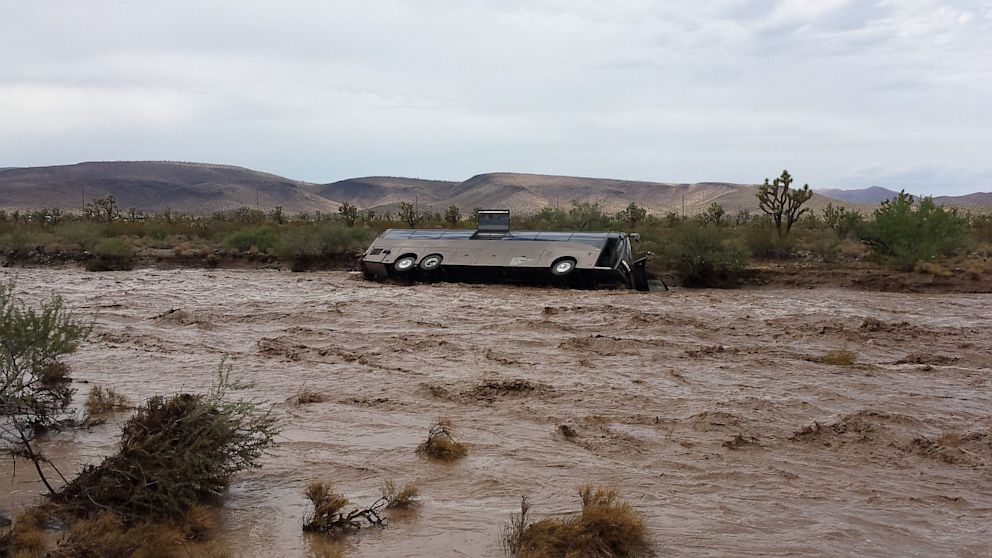 |
| This Tour Bus was swept away in Northern Arizona by a flash flood |
MOUNTAINS. The shortest distance between two points may be a straight line but that's debatable and it's definitely not the fastest or easiest. Arizona has more mountain ranges than any other state. Not the tallest or biggest, just more of um. There are also many vast relatively flat areas between these ranges, oddly enough, also called ranges (depending on who yer jabberin' with). The immense wide-open views alone can take your breath away, not to mention the towering mountains, expansive canyons and truly remarkable washes, plateaus, lakes, spires and hilly open range. A good day hike can take you from high desert and grassy lowlands, through the Chaparral to high pine forest. Ridge walking and reading the terrain are helpful skills to find the path of least resistance, especially in cross country excursions.
 |
| Vegetation life zones of Sonoran Deser |
Lastly, in hopes it's remembered...
HEAT. The desert is hot, extremely hot, almost unbearably hot much of the year. At times it seems too hot to move, and that's why many things don't. It's hot and dry. June thru September the temperatures can be over 117' F (47' C) much of the day and get all the way down to 99' F (37' C) at night, with 6% humidity. There is no relief. Your sweat evaporates faster than it comes out of you and it comes out fast. The intense relentless sunlight bounces off the rocks under you giving you sunburn in places you never had one before. Without water your body will begin shutting down in 2 days. By the 3rd you'll wish you were dead, if you still retain the wherewithal to wish. By the 4th, you will be.
I don't put it like this to be dramatic. (Ok. Maybe a little) but this is the reality here.
Shade is your friend. It can be 20' F (6' C) cooler in the shade. If you are lost without water and don't know where there is some, you need to do everything you can to conserve bodily stores. Move only at dawn and dusk or at night if there's a moon. Rest during the day in the shade. Find water. Or make water with a solar still. Water and shade. These should be you focus.
You should pay close attention to the water you hike with. When it's half gone, you need to turn around.

You may be able to trust hikers coming from where you are going who tell you about watering holes, but then you have to find it. Get a good description. Have them point it out on the map.
This all may sound silly to someone from another, less extreme, part of the country. I realize that. The folks from places like Alaska will understand though, in reverse. It is the sad truth that people come here from all over, go on a short day hike in one of our nice city parks strolling up a short desert mountain, and have to be rescued by our first responders. Happens 5 times a day or more during the hot months. Rescued, in a city park! Not because they're injured or lost. Just because they didn't have enough water and are suffering severe dehydration or worse, heat exhaustion and they can not go on. Some don't make it. The gear shack I work at supplies our firefighters their hiking boots. They are required to keep them in their fire truck because they use them so many times every day.
Remember what the buzzard says;
"Welcome to Arizona. Send more tourists. The last ones were delicious."
The Sonoran Desert is as beautiful as it is unforgiving. Travel in it is to be considered, not taken lightly.
Desert travel is incredible and entirely doable, if you have water. I always laugh when I read about ultralighters doing 3 days and nights with a 12 pound pack. That's what my water weighs. For an overnighter!
SIDE NOTE: It is interesting what the wide open spaces of the Sonoran Desert do to one. After growing up here mostly, when I hike in heavily wooded areas, I always feel a slight sense of claustrophobia. The forest would be really nice without all those trees in the way. ; )
Oooo! And one last thing! While I'm thinking of it.
INFLATABLE SLEEP PADS. Don't leave an inflatable fully inflated during the day in or out of your shelter. The heat can cause it to expand and rupture. When you leave camp to go explore or whatever, deflate it about half way.
.More research - GORP (Great Outdoor Recreation Pages)has some great pratical advice pages. Here; http://www.gorp.com/camping-guide/camping-advice-guide-sp.html
Wow. That post got a little more involved than I originally intended. I hope that all helps somebody out there.
That's my 3 Part series on Desert Hiking Tips. Leave a comment with your input.
Tread lightly,
Packman
#goplayoutside

No comments:
Post a Comment